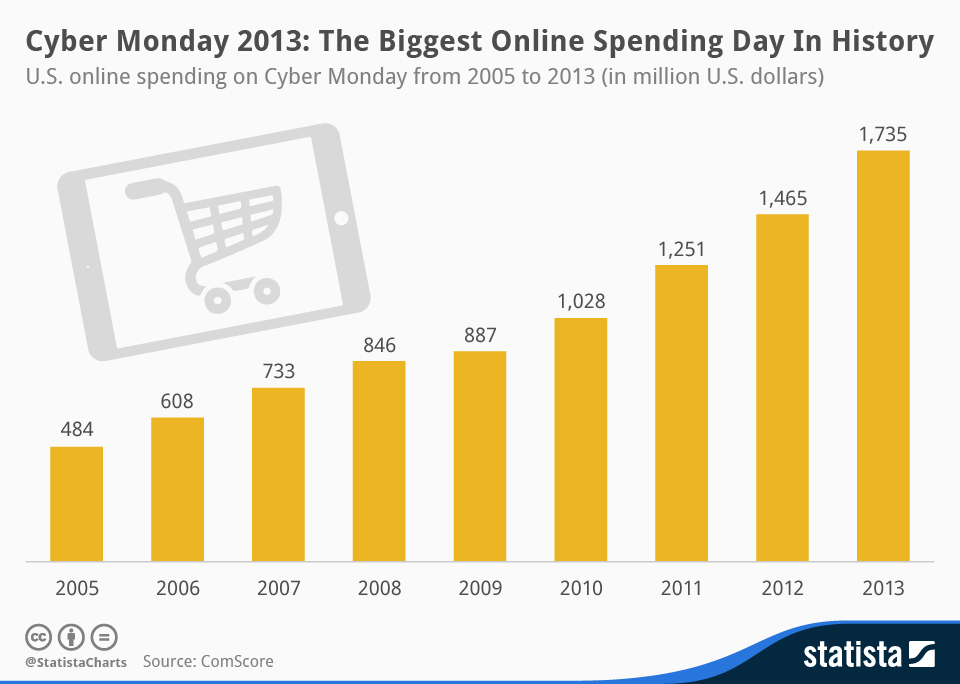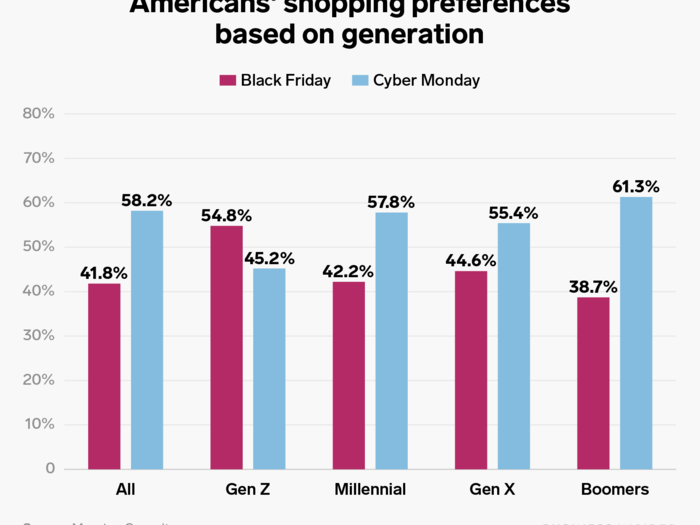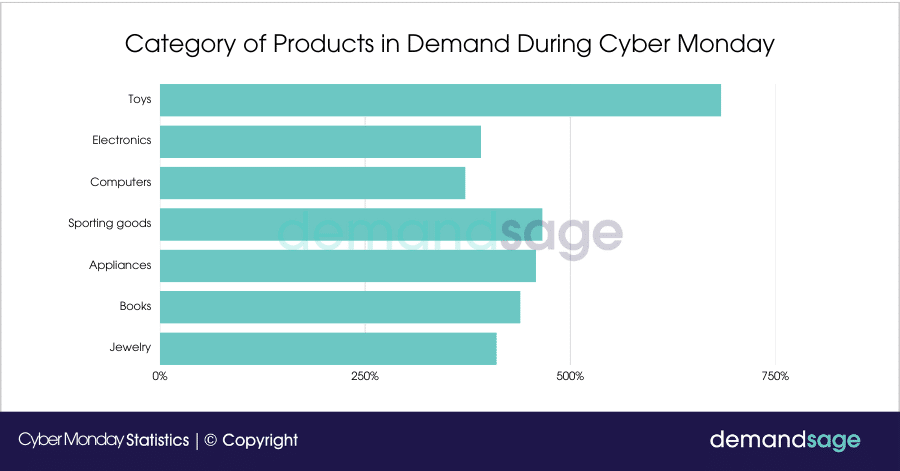Cyber Monday is a very important day for e-commerce markets around the world.
This is the day businesses try to maximize their profits. Moreover, shoppers plan various purchases in the weeks leading to this day.
Thus, Cyber Monday has the record’s highest online spending every year.
In fact, online products also have all sorts of deals, discounts, promotions, and offers during this long weekend.
If you are wondering what makes it so special?
Here are some of the latest Cyber Monday statistics to give you an idea of its uniqueness.
Top Cyber Monday Statistics
An average American citizen spends at least around $500 in Cyber Week.
The 2023 Cyber Monday saw a 43% increase in spending as compared to 2022.
The UK has an awareness of 89% of the issues that concern Black Friday and Cyber Monday.
US consumers spent $12.4 billion in 2023 on Cyber Monday.
Consumer spending grew around 9.7% YoY.
Build trust & FOMO
Highlight real-time activities like reviews, sales & sign-ups.
The History of Cyber Monday: Tracing the Holiday from the 1950s
Cyber Monday is a term that, like Black Friday, has economic origins. Cyber Monday is celebrated on the Monday after Thanksgiving.
This weekday is an essential event for the e-commerce markets across the US as they see an enormous boost in sales and website traffic.
The Cyber Monday tradition started back in 1950 as an in-store event.
Retail stores all over the US lowered their prices and extended operating hours.
This slowly morphed into a worldwide event with the introduction of online retail around the late 90s and early 2000s.
In 2005, Ellen Davis and Scott Silverman of the National Retail Federation officially termed this event’ Cyber Monday.’
The holiday season in 2004 had seen some fantastic numbers and profits.
This was a noticeable trend even before 2004, and a thorough study led the NRF and multiple media outlets to declare this particular Monday as beneficial to online retail.
The Cyber Week celebration has spread to other countries over the years.
Most European countries are aware of Black Friday and Cyber Monday, with economies like Germany, France, Spain etc. participating.
The UK, India, and Japan, too, have great deals on e-commerce platforms this week.
Almost the entire globe is influenced by this phenomenon and has its own version of it.
What Makes Cyber Monday the Biggest Online Shopping Day
Cyber Monday is part of the Cyber Week that starts with Thanksgiving and lasts till the Monday following it.
The term Cyber Monday was coined in 2005 due to a trend that the NRF has noticed over the past few years.
This was partly due to the holiday season and the rush to buy gifts for family and friends.
The most important factor, however, was the discounted prices that retailer websites and in-store businesses offered to attract more customers and drive sales.
Nowadays, online retailers offer various Cyber Monday deals such as special promotions, sales, and discounts in different categories, as brick-and-mortar stores do on Back Friday deals.
Cyber Monday is a very important day in business calendars as retailers try to make maximum profit out of the Cyber 5.
Millions of consumers set out to spend on this shopping holiday. The Thanksgiving week drives a significant amount of revenue and boosts the economy through various deals and discounts.
From big retailers like Amazon to small businesses, almost everyone benefits from this week.
Also see: 21 Cyber Monday Marketing Ideas to Skyrocket Sales
General Cyber Monday Statistics
Here are some general Cyber Monday stats:
1. 44 million people used their desktops or laptops to place orders on Cyber Monday
2. Shopify businesses accounted for around $9.3 billion in revenue between Black Friday and Cyber Monday.
3. Mobile sales account for about 59% of all sales in 2023, according to Adobe Analytics Data.
4. According to Exploding Topics, an average American citizen spends at least around $500 in Cyber Week.
This means almost every citizen or family in the US spends the given amount, massively driving sales on this shopping event.
5. 56% of American shoppers look forward to Amazon deals on Cyber Monday.
6. According to the Campaign Monitor 2010 report, 28 countries celebrate Cyber Week.
Build trust & FOMO
Highlight real-time activities like reviews, sales & sign-ups.
Cyber Monday Sales: Year-over-Year Growth
Cyber Monday revenue has continued to grow over the years. Some figures are:
7. 2005 recorded $484 million in sales and broke the $1 billion mark by 2010.
8. In 2019, Adobe Analytics predicted $9.2 billion in sales, which further increased to $9.4 billion due to late-night shoppers grabbing Cyber Monday discounts.

9. The image above indicates that 2022 recorded a total of $11.3 billion in web sales.
10. According to Digital Commerce, US consumers spent $12.4 billion in 2023 on Cyber Monday.
This means there was a $1 billion leap from Monday last year, a significant increase in interested consumers, and potential revenue growth for many different industries.

11. Online retail websites recorded the highest numbers of the decade in 2013, totaling around $1,735 billion.
Record-Breaking Cyber Monday Sales Figures
Some interesting Cyber Monday stats are:
12. Online holiday sales were up 7.3% in 2023 as compared to 2022.

13. According to data sourced from Adobe Digital Insights, 2020 saw a 30% increase in Consumer spending.
14. According to Techopedia, The 2023 Cyber Monday saw a 43% increase in spending as compared to 2022.
That shows the impact of online marketing and spreading awareness about Cyber Monday deals through various channels, which was a driving factor.

15. The consumer demand rose 5.8% in 2022, according to Adobe Analytics.
16. 2018 saw $7.9 billion in online sales on Cyber Monday.
Build trust & FOMO
Highlight real-time activities like reviews, sales & sign-ups.
Average Spending per Shopper on Cyber Monday
The spending capacity varies from person to person, depending on the income.
Listed below is the average spending during Cyber Week.
17. Around 31% of US shoppers spend $200 or more on Cyber Monday.

18. According to Statista, Shein and Walmart saw an average spending of $49 in 2023.
19. In 2019, the average US shopper spent $362 on the Thanksgiving weekend.

20. 20.21% of consumers spent between $200 to $399 in Cyber Week in 2021.
21. In 2023, during the peak hour between 10 and 11 pm, shoppers spent $15.7 million every minute.
Also See : 14 Thanksgiving Marketing Ideas to Skyrocket Sales
Cyber Monday Consumer Statistics
The consumers are the central link in the retail chain. Their preferences, demands, and behavior are kept at the forefront while planning sales.
Here are some key consumer Cyber Monday statistics:
What are the Demographics of a typical Cyber Monday Shopper?
22. According to NRF, 196.3 million people shopped on Monday last year.
23. According to Finances Online, the UK has an awareness of 89% of the issues surrounding Black Friday and Cyber Monday.
This places the UK as the potential second lucrative market for retailers during the Cyber Week after the US.
24. 24.43% of purchases were made on mobile devices in 2023.
25. According to Drive Research, 88.3% of people who shop online prefer Amazon for Cyber Monday deals.
Consumer Statistics on Cyber Monday According to Age Groups
Age is a major factor that influences sales as it affects spending capacity, awareness, access to online retailers, etc. Some age-based Cyber Monday statistics are:
26. 26.61% of Millennials and GenZ are likely to shop for Cyber Week from Target

27. Baby Boomers were the largest group, with 61.3% of people spending on Cyber Monday in 2018.
28. Excluding those aged 65+, Cyber Monday was a preferred day to shop online for all age groups.
29. 27% of GenX are likely to spend $1,000 or more during the Thanksgiving week.
Gender-based Stats on Cyber Monday
Gender also plays an important part in driving sales during the holiday season, as preferred industries generate significant revenue by offering attractive deals. Some gender-based statistics are:
30. Women are more likely to use promotional emails to discover deals for the Black Friday Weekend at 64%more than men.
31. Men are most likely to spend between $251 to $500 on Cyber Monday
32. About 73% of men believe that Black Friday deals are a great value for money as compared to women.
Income Levels and Spending Habits
Income levels dominate spending habits as income dictates the amount you can spend on holiday gifts.
Some related statistics are:
33. Shoppers who earn $50,000 or less plan on spending about $320 on holiday shopping.
34. PWC stated that households with an income of more than $25,000 will spend 18% more in 2023.
35. Drive Research estimated that 21% of consumers will spend less in 2023 than in 2022 due to rising costs.
36. 37% of shoppers use the buy now, pay later option on deals.
Build trust & FOMO
Highlight real-time activities like reviews, sales & sign-ups.
Cyber Monday Shopping Behavior Statistics
Consumer behavior dictates the type of discounts, deals, and offers that are presented by retailers. Some consumer behavior statistics are:
When Do Shoppers Start Planning for Cyber Monday?
Consumers may plan a long while ahead of the holiday season to ensure they have the budget. Some statistics are:
37. 64% of global shoppers make plans to shop on Cyber Monday.
38. Around 57% of consumers start shopping before Thanksgiving, according to a 2021 report.

39. According to Optimove, 50% of consumers planned their holiday shopping by the end of October 2023.
How Much Time Do Shoppers Spend Researching Deals?
Most customers research and ask around if a product is good before buying it.
Here are some statistics:
40. At least 89-96% of consumers spend more than ten minutes researching their purchases.
41. 53% of shoppers conduct thorough research to get the best possible deals.

42. 54% of shoppers bought items in their wishlist on Cyber Monday in 2023, While 19% viewed items on sale highlighted by influencers.
Popular Product Categories & Top-Selling Items
Some certain products and items are sure to sell and be preferred by the customers. Some of them are:
43. 49% of all consumers chose to buy Clothes and Accessories in the Cyber Week in 2022.

44. Toys were the preferred purchase in 2023, with sporting goods coming in a close second.
45. Electronic goods are estimated to be a choice for 49% of consumers in 2025.
Impulse Shopping vs. Planned Purchases
Many of us make impulsive decisions at shopping stores or even when shopping online. Here are some statistics about planned and impulse buys:
46. 58% of consumers admit to impulse buying during the Cyber Week of 2021.
47. 47% of consumers made spontaneous purchases on Cyber Monday in 2022.

48. 57% of consumers plan ahead of shopping holidays in 2022

49. 57% of German consumers made impulse purchases in 2023, while 38% set a budget.
Online vs. In-Store Shopping on Cyber Monday
The mode of Shopping also affects sales. Whether we are shopping online or in-store, we decide the amount we spend and the quantity we buy. Some statistics are:
How Retailers Are Driving Cyber Monday Sales
Retailers mainly drive Cyber Monday sales by increasing discounts. Some of the statistics are:
50. 31% of electronic goods had discounted prices as compared to 2022.

51. Amazon saw the highest retail sales of around 23% in 2022 on Cyber Monday due to attractive Cyber Monday discount codes.
The Shift Towards Online Shopping: Data from the Past Decade
There is a global preference for online shopping, with more shoppers deciding to shop online. Some interesting statistics are:
52. As of July 2025, reports show that almost 200.4 million customers shopped online during Cyber Monday events.

53. According to NRF, 77 million people made online purchases in the holiday season of 2022, as compared to 22.6 million in-store sales.
Build trust & FOMO
Highlight real-time activities like reviews, sales & sign-ups.
Comparing Cyber Monday to Black Friday
Cyber Monday and Black Friday are two major retail events.
Here are some Cyber Monday and Black Friday statistics comparisons:
54. Reports show that more revenue was generated through Cyber Monday than Black Friday, according to Techopedia.

55. According to Active Campaign, $10.7 billion was spent on Cyber Monday as compared to $8.9 on Black Friday in 2021.
The Impact of Cyber Monday on the Economy
Cyber Monday has a significant impact on the global economy.
Cyber MondMonday’snomic Impact: Beyond Retail
Cyber Monday is noted as one of the most profitable holidays in the US and several European Countries.
This is due to the enormous consumer traffic it draws in, both online and in-store.
This can be mainly due to the deep discounts offered by retailers or how close it is to the Christmas season.
This prompts customers to shop for the holidays in advance and get great value-for-money deals.
These factors, along with well-placed social media ads as well as advertising through multiple channels, can lead to a boost in sales, ultimately affecting the economy.
Cyber Monday Trends to Watch
Mobile Shopping Continues to Grow
With our growing reliance on mobile phones and the internet, the trend of making purchases through mobile devices is predicted to grow.
Currently, this sits at around 53%. Therefore, retailers may want to target mobile-friendly ads to reach a broader audience.
Global Reach is Important
As mentioned in the blog, 28 countries currently celebrate Cyber Monday; marketing this cyber attraction to more places in ways unique to that country can bring more potential sales to businesses and help them locate new, niche markets.
Feasible Discounts
Consumers research a lot about deals and discounts on various platforms; therefore, having sound offers on your products is essential.
Today, there are many options to choose from, and thus, an ever-shifting consumer base is created.
Businesses should always consider the best possible discount prices that benefit them as well as the consumers.
Wrap Up
The Cyber Week is a significant event for the business and retail world. The companies are trying to draw out maximum profits this week.
With the growth of online retail, consumers shifted from in-store purchases to online orders that are delivered right to their doorstep. This led to the creation of Cyber Monday.
Most of the purchases today happen on Mobile, with Cyber Monday sales growing year over year.
The Stats given above highlight the importance of Cyber Monday and its impact on e-commerce sales and the economy in general.
Sources










